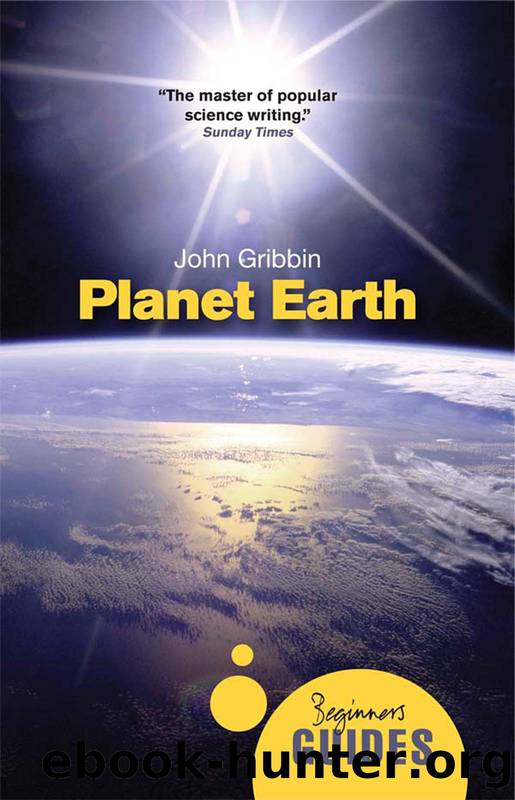Planet Earth by John Gribbin

Author:John Gribbin [Gribbin, John and Mary]
Language: eng
Format: epub
ISBN: 9781780740423
Publisher: Oneworld Publications
The edge of space
Above the stratopause, there are other, even more tenuous, layers of the atmosphere, which eventually fade away with no distinct upper boundary into empty space. Above an altitude of about fifty kilometres (thirty miles), there is a cooling layer called the mesosphere, which ends at an altitude of around eighty kilometres (fifty miles), at the mesopause. Although the density of the mesosphere is low, there are enough atoms and molecules there to provide the friction that burns up small pieces of debris from space, typically the size of sand grains or particles of grit, as shooting stars, or meteors. The temperature of the mesosphere falls off with increasing altitude, to a low of about -120 degrees Celsius, or -185 degrees Fahrenheit, at the mesopause. Above that lies the thermosphere, a layer in which the temperature increases, according to the definition of temperature in terms of the average speed of the molecules, to thousands of degrees Celsius; but there are so few atoms and molecules around that the concept of temperature doesn’t really mean anything.
The energy which makes the molecules of the thermosphere move so fast comes from solar X-rays and some types of ultraviolet radiation, so the thermosphere also acts as a shield around the Earth. These forms of radiation are very energetic. The energy absorbed by the atoms and molecules up there is so great that it can knock electrons right out of atoms, leaving positively charged ions behind. For this reason, the thermosphere is also known as the ionosphere. It also ‘breathes’ in and out, with a twenty-seven-day rhythm related to changes in the amount of energy arriving from the sun, as the sun rotates. Because it is electrically charged, the ionosphere can reflect some frequencies of radio waves, which can be bounced right around the world as a result. Before the advent of communications satellites, this was an important means of global communication, and is still used by amateur radio enthusiasts to talk to people on the other side of the globe.
Even above three hundred kilometres (about two hundred miles), where the International Space Station orbits, there are still billions of atoms of air in every cubic metre. This is only a tiny fraction of the number of molecules in a cubic metre of air at sea level, which is a staggering fifty million billion billion. But it is enough to provide a drag, which lowers the orbit of the Space Station by about thirty metres, or one hundred feet, per day. Fortunately, as the space station’s designers anticipated, the station gets a boost to higher altitude when a space vehicle docks with it; this can push it upward by as much as a kilometre – about three thousand feet.
The uppermost regions of the atmosphere, from an altitude of about 500 to 750 kilometres (300 to 450 miles), are sometimes known as the exosphere, because molecules at this height can escape into space. But because there is no clear-cut edge to the atmosphere, the
Download
This site does not store any files on its server. We only index and link to content provided by other sites. Please contact the content providers to delete copyright contents if any and email us, we'll remove relevant links or contents immediately.
Sapiens: A Brief History of Humankind by Yuval Noah Harari(14209)
Sapiens by Yuval Noah Harari(5280)
Pale Blue Dot by Carl Sagan(4883)
Homo Deus: A Brief History of Tomorrow by Yuval Noah Harari(4798)
Livewired by David Eagleman(3663)
Origin Story: A Big History of Everything by David Christian(3631)
Brief Answers to the Big Questions by Stephen Hawking(3354)
Inferior by Angela Saini(3260)
Origin Story by David Christian(3132)
Signature in the Cell: DNA and the Evidence for Intelligent Design by Stephen C. Meyer(3054)
The Gene: An Intimate History by Siddhartha Mukherjee(3029)
The Evolution of Beauty by Richard O. Prum(2924)
Aliens by Jim Al-Khalili(2775)
How The Mind Works by Steven Pinker(2713)
A Short History of Nearly Everything by Bryson Bill(2616)
Sex at Dawn: The Prehistoric Origins of Modern Sexuality by Ryan Christopher(2472)
From Bacteria to Bach and Back by Daniel C. Dennett(2432)
Endless Forms Most Beautiful by Sean B. Carroll(2413)
Who We Are and How We Got Here by David Reich(2385)
